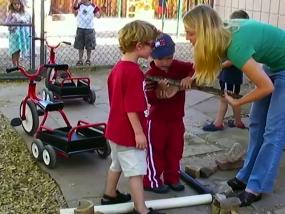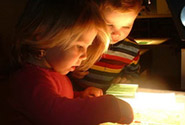Social Emotional Learning: Effective Guidance

Respect Boundaries: Promote Self-Other Awareness (age: 15 months) In this video clip, Diego (on the right, seated beside teacher) and John (on the right, wearing an orange shirt) are confused about whose clay is whose. The teacher helps reorient Diego by saying, “Diego, that’s John’s work. Here’s Diego’s clay. Here’s Diego’s clay.” The teacher works to increase the toddlers’ social knowledge about enjoying participation in a group while respecting each group member’s work. Also observe that the teacher does not say, “Here’s your clay,” but instead, refers to Diego in the first person. She likely recognizes that pronouns (words used in place of nouns) are challenging for young children, and an understanding of possessive pronouns used to show ownership (your, your, my, mine), will begin to develop around two years of age. Self-Advocate: Talk to Your Peer (age: two years) In this video clip, the teacher works to strengthen the child’s communication skills by encouraging him to self-advocate with a peer. Evan begins playing with a toy school bus nearby Aviva, who is building in the block area. Aviva pulls the school bus from Evan’s hands, as she says, “No, I’m building with that. This is my bus. It’s the school bus. I got it out.” Calmly, Evan turns to look up at the off camera teacher and says, “I use it” (00:16). Notice that the teacher resists intervening and instead, decides to help the child learn to better communicate with a peer about his desires. She encourages Evan by saying, “Can you talk to Aviva” (00:16)? Evan turns toward Aviva and says, “I want that. I want that.” (00:20). Aviva is engaged in building and says, “It’s a building…Watch out. It’s gonna fall.” Evan recognizes that Aviva is not responding to his message, so he turns to the teacher and says, “I want the school bus. I want the school bus” (00:40-00:46). The teacher continues encouraging him to talk to his peer. Evan gives it another try by saying, “I want the school bus.” Notice that Evan clarifies his message to Aviva by replacing the pronoun (that) with the noun (school bus). Aviva replies by saying, “No way” (00:51). When Evan’s request is declined, the teacher supports the child by verbally modeling an alternate strategy he can use to secure a turn. She says, “Can you ask her if you can use it when she’s all done” (00:54)? Evan turns toward Aviva and says, “I use it when you done?” Aviva says, “Okay.” Democratic Discussion: Facilitate, Focus, Participate (age: four years) A group of four-year-old children work with their teacher to decide if a piece of music relates to a scene from their play. Watch the full video and note the strategies the teacher uses to help the children frame the problem, engage in discussion, focus on their goal, and recognize that each child's thinking is valued. Facilitate Discussion In segment 1, the children listen and share opinions about whether or not the people in the castle could dance to the music. The teacher promotes the children’s participation in democratic decision-making by framing the problem – two points of view, and encouraging the children to have a discussion. The teacher says, “Alright, you say they could. You say they can’t. So, I’m going to stop it and let’s talk about this.” Focus Discussion In segment 2, the teacher supports focused discussion by reminding the children of their goal. Notice that she lends her full attention and listens carefully as the child shares her ideas. She then speaks in an affirming but clear manner to remind the group about their goal. Here is what the children and teacher say in segment 2: Teacher: What are your reasons for thinking it could be the music? Elsa: Maybe it could. It could go up into air, and the dragon could go up and get it back. Teacher: But this is not about the dragon though, right now. This is about, in the very beginning of the story, we see that all the people are dancing in the castle; so, we’re searching for dancing music. Encourage Participation In segment 3, the teacher encourages group members to participate, while conveying that each child’s opinion matters. The teacher says, “Do you have an opinion Cassidy, while Elsa’s thinking (touches Elsa’s shoulder); do you have an opinion?" The teacher manages the group discussion by encouraging another child to participate, but is careful to let Elsa know she is giving her time to think and will come back to her. Cooperative Engagement: Invite to Join (age: five years) In this video clip, the teacher encourages Rosie to invent an iconic sound for the symbol she has drawn to represent herself. Rosie voices a sound like “whooosssshhhhh” and gestures “falling” with her hands. The teacher proposes that Rosie find an instrument that makes a similar sound. Nearby, the teacher notices Brooke and Javi climbing and looking through a basket of balls. She works to increase the children’s social competence by encouraging them to engage cooperatively in the investigation. She invites them to join by saying, “Hey Brooke and Javi, do you want to help us? Rose is going to find some sounds for her symbol, but she thinks that the sound of leaves falling would probably do, like ‘whooosh’. We’re going to see if there’s any instruments that make that sound. Do you want to help us, Javi? Let’s see if there are any instruments that go “whooosssshhhhh”. Conflict Resolution: Facilitate Problem Solving (age: four years) In this video clip, two boys want to use the same stick. Jeremis wants to add the stick to the perimeter he is building. Noah wants to use the stick to make cement. Notice the strategies the teacher uses to help the boys reframe their problem in a positive manner. She approaches the boys with a calm demeanor. The teacher ensures the children’s safety by asking them to stop pulling on the stick and offers them a pro-social alternative, to talk about it. She works to support the children’s emotional development by giving the boys a few moments to regain self-control before offering to hold the stick. Skillfully, the teacher encourages the boys to problem solve by figuring out what they are going to do. Notice that she says, “Guys, guys. Okay, let go for a minute, and I’m going to hold it while you figure out what you’re going to do,” instead of saying, “…what I (the teacher) am going to do.” Skillfully, the teacher encourages the boys to problem solve by figuring out what they are going to do. Notice that she says, “Guys, guys. Okay, let go for a minute, and I’m going to hold it while you figure out what you’re going to do,” instead of saying, “…while I (the teacher) figure out what I am going to do.” The teacher also lets the children know what they say is important by bending down to talk with the children at their eye level. She helps the children define the problem by saying, “It looks like two people need it (the stick).” The teacher then encourages the children to take responsibility for solving the problem by saying, “Well, what are we going to do? What can we figure out? Two friends need the same thing” (00:48). Here, the teacher uses the pronoun ‘we’ versus ‘you,’ but still refrains from using the pronoun ‘I’. Here is what the children and teacher say: Noah: We need it to make cement. Jeremis: No, you can't use it (00:12). Noah: We need it (gestures frustration with arms) to make cement. Jeremis: No, you can’t use it. Noah: We need it. (grasps stick) We need it (00:18). Jeremis: No! Noah: We need it. Noah and Jeremis struggle for possession of the stick (00:19). Teacher: Uh-oh. Noah and Jeremis, stop pulling on it and talk about what you are going to do. Teacher: Guys, guys. Okay, let go for a minute, and I’m going to hold it while you figure out what you're going to do (00:28). Jeremis: We need it for... Noah: And we need it to make cement. Teacher: It looks like two people need it (00:41). Jeremis: No, I need it. Noah: We need it. Jeremis: I need it too. Teacher: Well, what are we going to do? What can we figure out? Two friends need the same thing (00:48). Accept an Active Role: Define & Foster Group Membership (age: five years) Rosie and Brooke have found instruments that make sounds to represent Rosie’s symbol (“whooosssshhhhh”). The teacher invites Rosie to record the sound of her instrument on the computer. Notice that the teacher skillfully involves all three children in listening to decide if the sound is a good match. The teacher poses an invitation to Javi, while also describing the role of participants as active listeners. She says, “Hey, Javi, we’re going to record a sound. Do you want to come listen to it with us and see if it matches Rosie’s symbol (00:13)? The teacher tells the child that his perspective is valued by saying, “I want to hear what you think. The girls have found two sounds that they think could be Rosie’s symbol” (00:19). She fosters a sense of group membership by saying, “You want to be really quiet. Let’s listen, me and you together, and you tell me if you think it sounds like Rosie’s symbol (00:24). After Rosie finishes recording the sound, the teacher continues to support the participation of all three children. She turns toward Javi and excitedly says, “Ready? We’re going to listen to what they recorded” (00:47).Keywords: mixed ages, children-teacher, communication, self, other, problem solving, conflict resolution, teaching, videative Length of video: 5 minutes, 45 seconds
